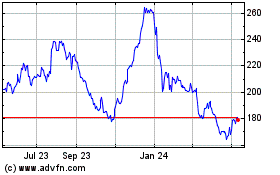FAA Tightens Safeguards on Lithium Batteries on Jetliners, Smaller Planes
August 27 2016 - 9:26AM
Dow Jones News
By Andy Pasztor
Three years after fire-prone lithium batteries led to the
temporary grounding of Boeing Co.'s flagship 787 fleet world-wide,
U.S. regulators are ratcheting up safety standards, as they approve
use of various types of lithium power cells on different airliners
and business aircraft.
Reflecting this new approach, the recent approvals cover
nonrechargeable lithium batteries, which industry officials said
are used to power everything from emergency exit signs to cockpit
equipment to emergency underwater locator devices. The batteries
that prompted so much public attention on 787 Dreamliners, by
contrast, are larger, more powerful and rely on rechargeable
technology to provide backup electric power.
Still, government documents highlight that many of the
identified risks are similar between the two categories of
batteries. U.S. regulators are relying on lessons learned from
earlier problems with 787 batteries to spell out safety rules for a
wider array of new applications for nonrechargeable versions on a
number of other models.
Details of the Federal Aviation Administration's decisions
reflect that "everyone is now much, much more aware of the issue"
in the wake of the prominent incidents with Boeing 787s, according
to Joe DePete, who heads up safety efforts at the Air Line Pilots
Association.
Lithium batteries are lighter, contain more energy and generally
require less maintenance than nickel-cadmium or other traditional
batteries. But experts describe them as more flammable, and
recognize they may be prone to internal short-circuits,
overcharging or other malfunctions that can result in fires or
explosive release of gases.
When the FAA initially approved the 787 battery systems for
backup power, both government and industry officials relied
primarily on engineering and mathematical analyses to support
Boeing's conclusions that the batteries wouldn't smolder or catch
fire even under operations considered extremely remote.
Ultimately, Boeing was forced to redesign its 787 batteries by
installing them inside rugged metal, fireproof containers that
preclude flames or hazardous chemicals escaping under any
circumstances, regardless of how unlikely those might be. Venting
tubes are intended to carry smoke, flames or vapors outside the
plane.
Now, U.S. regulators are mandating similarly tough safeguards
and fail-safe conditions for other applications. Over the past two
weeks, the FAA has issued or proposed rules, known as "special
conditions," spelling out strict safety standards for
nonrechargeable lithium batteries for certain Boeing 737 jets;
cargo and tanker versions of the company's 767 models; and some
modified, propeller-powered PC-12 business aircraft originally
manufactured by Pilatus Aircraft Ltd.
In every case, the FAA is requiring safety systems able to be
certified to keep dangerously high temperatures, flames or gases
from damaging aircraft under any circumstances.
As part of its 767 rules, for instance, the FAA said battery
designs should be intended "to eliminate the potential for
uncontrolled failures." But since "a certain number of failures
will occur due to various factors beyond the control of the
designer," according to the document, other safeguards are needed
"to protect the airplane and its occupants if failure occurs."
The agency also determined that such protections are essential,
partly because "service history shows that battery failure is not
extremely remote."
The FAA and European plane maker Airbus Group SE are locked in a
dispute over rechargeable lithium batteries used for backup power
on the latest versions of A350 jetliners. European regulators have
signed off on the design, which Airbus contends has more built-in
safeguards than rechargeable batteries used on 787s. Airbus is
balking at FAA demands that the batteries should be encased in the
same type of protective metal shielding now required for 787
jetliners.
The moves come as a joint industry-government panel, under the
auspices of the FAA's outside technical advisory organization, is
wrapping up work on comprehensive new standards for lithium
batteries. The result is expected to be tougher laboratory testing
requirements before new systems go into service.
Write to Andy Pasztor at andy.pasztor@wsj.com
(END) Dow Jones Newswires
August 27, 2016 09:11 ET (13:11 GMT)
Copyright (c) 2016 Dow Jones & Company, Inc.
Boeing (NYSE:BA)
Historical Stock Chart
From Mar 2024 to Apr 2024

Boeing (NYSE:BA)
Historical Stock Chart
From Apr 2023 to Apr 2024
